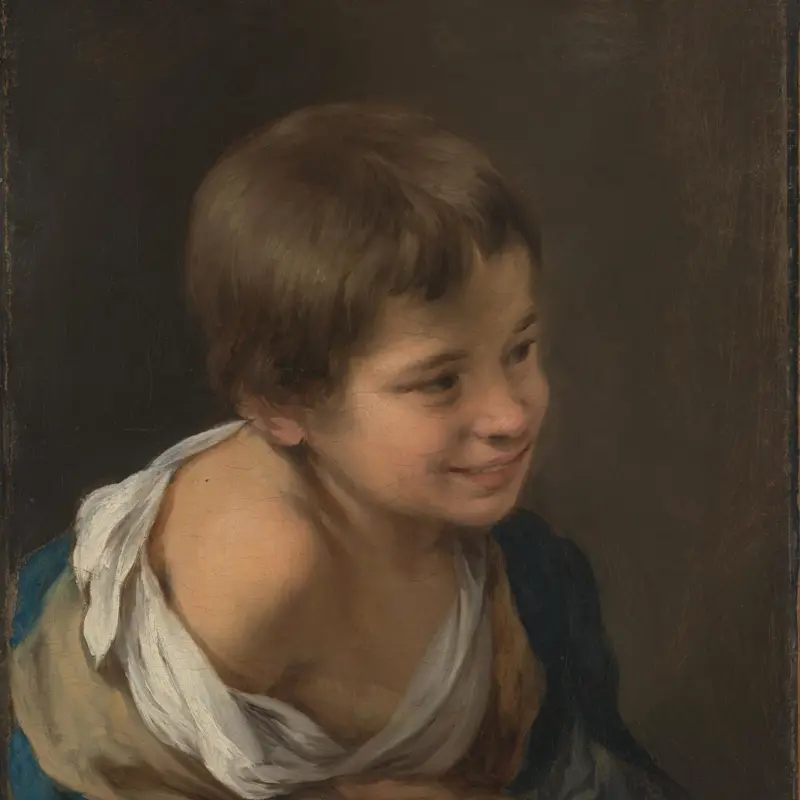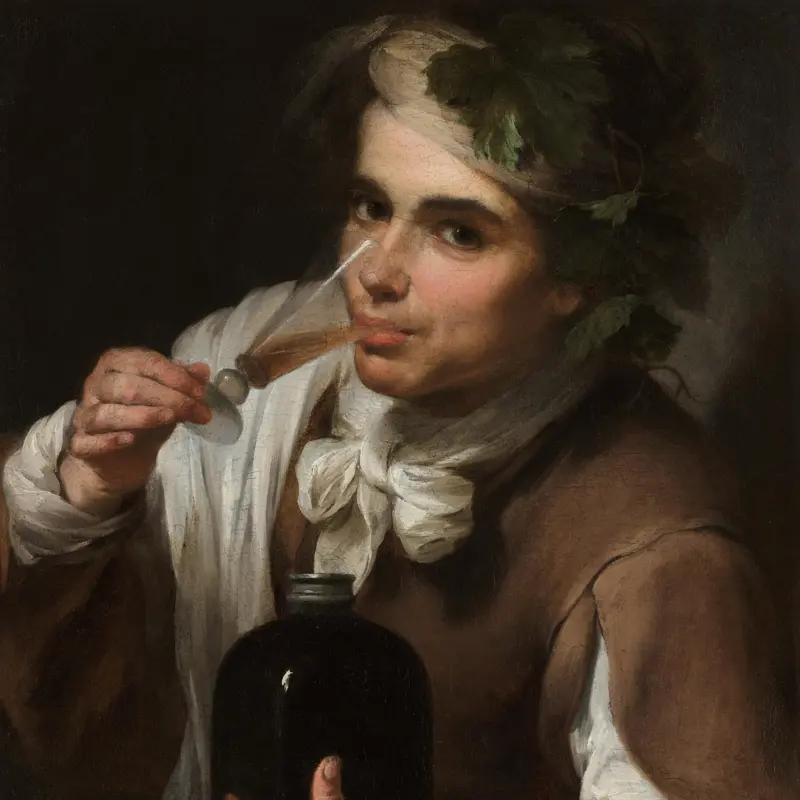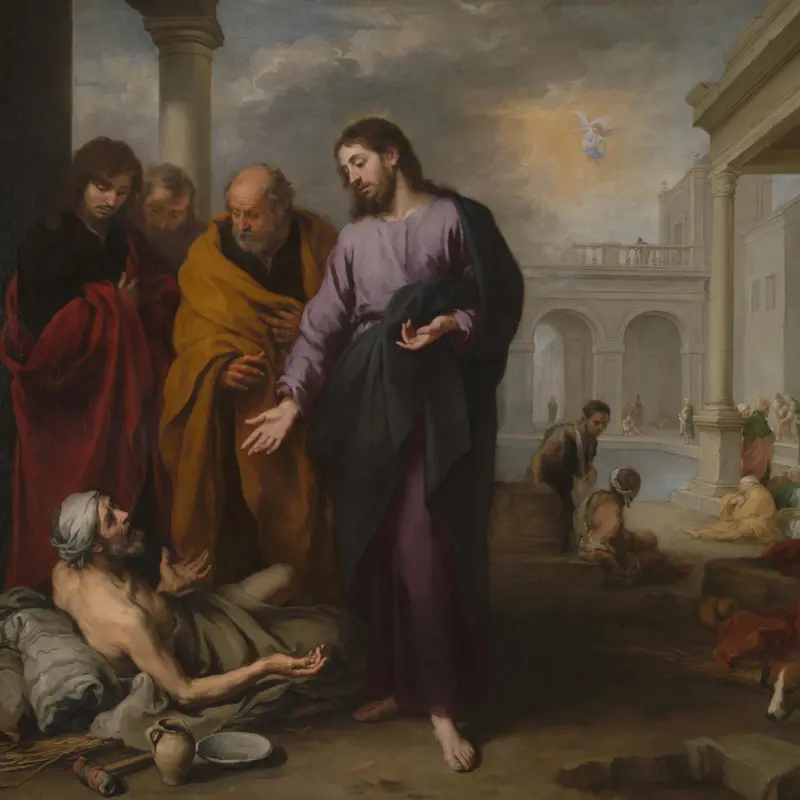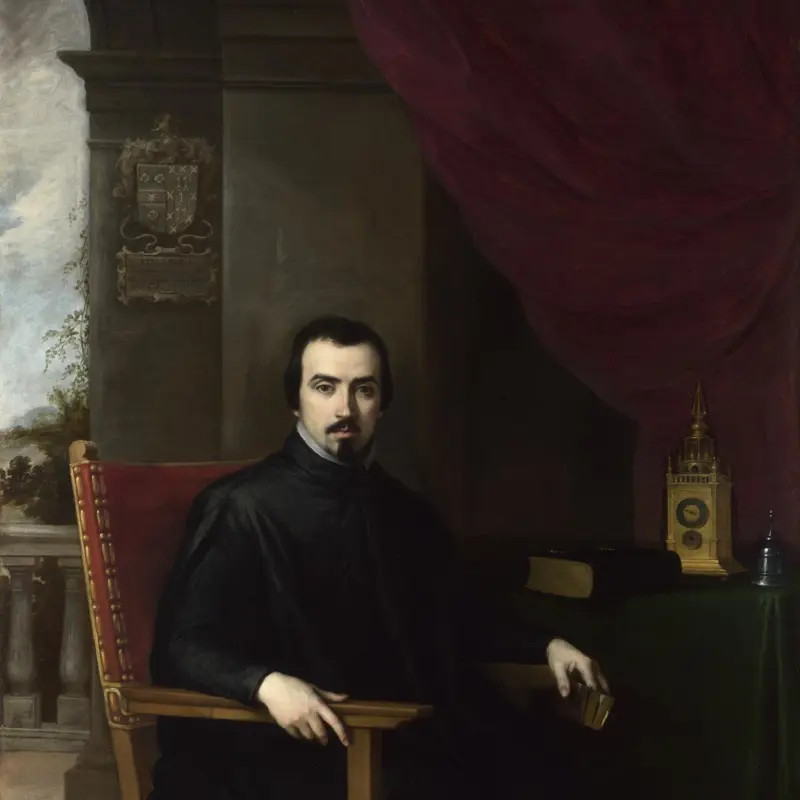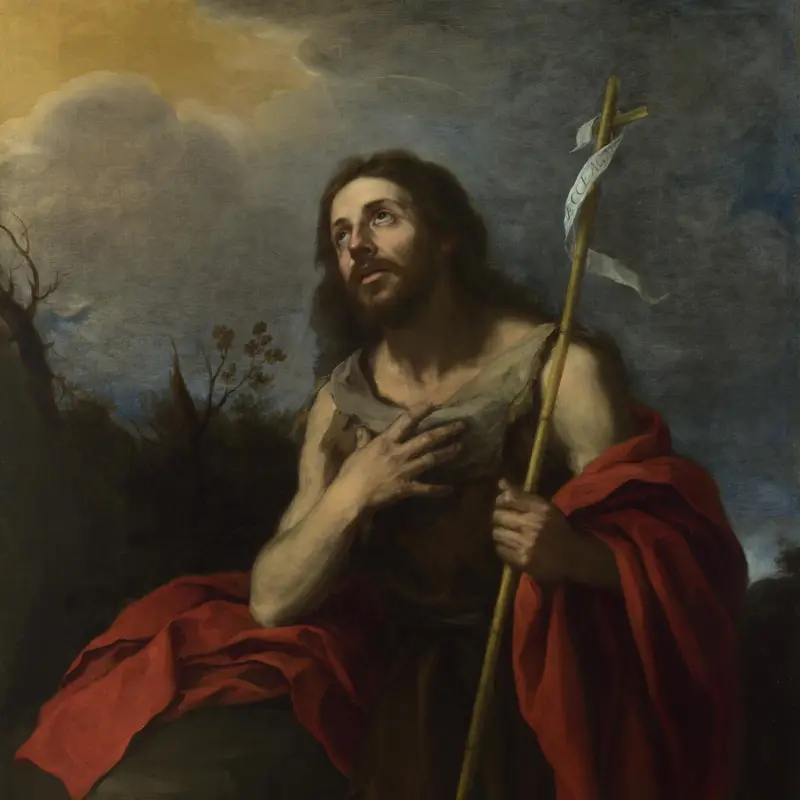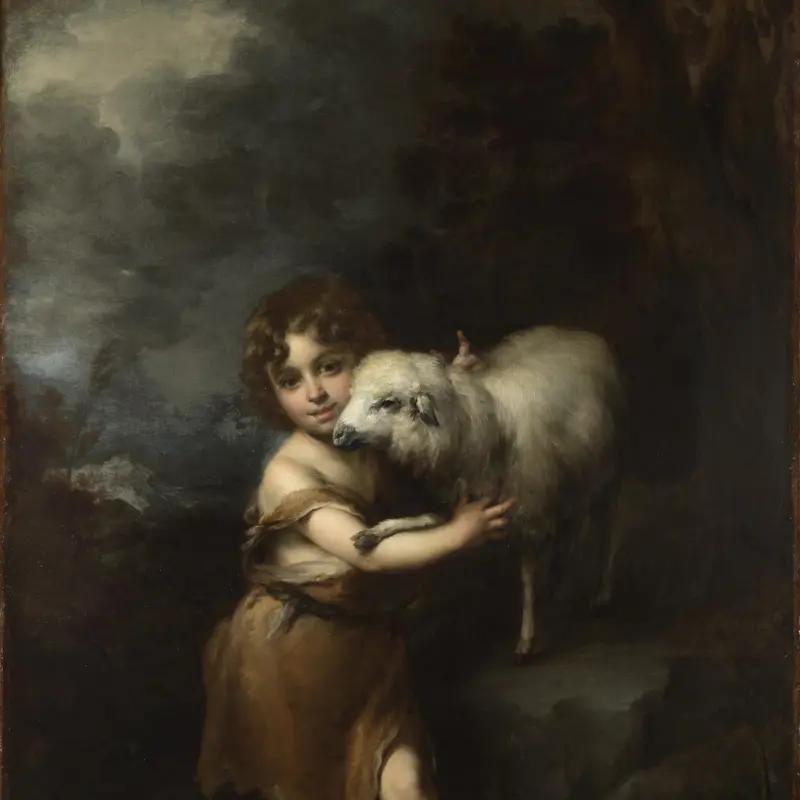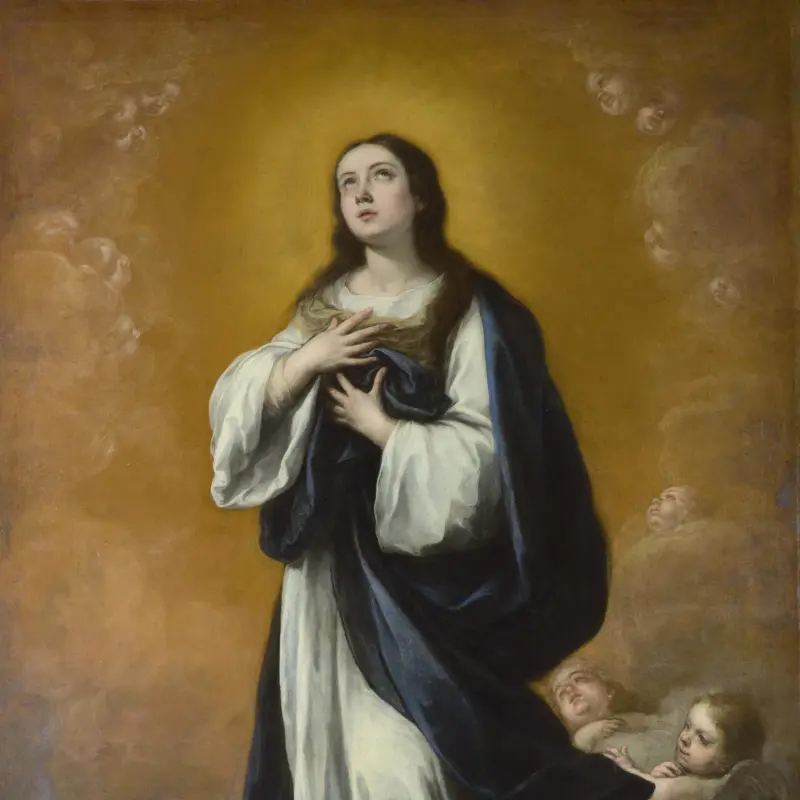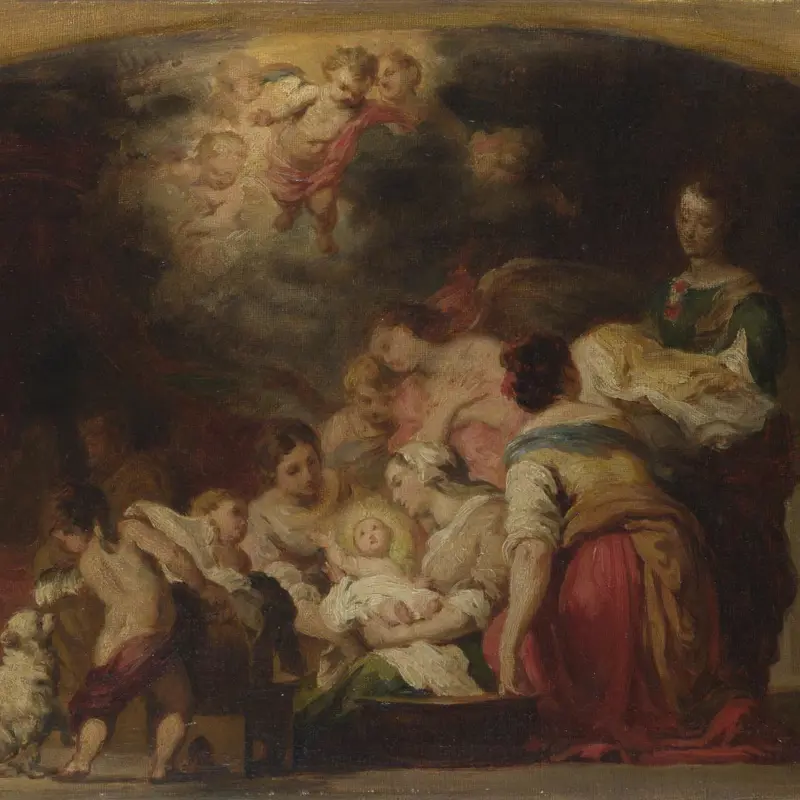Daniel Sobrino Ralston, our CEEH Curatorial Fellow in Spanish Paintings, goes behind the frame of Murillo's 'Self Portrait' and asks what could be on Murillo's mind as he paints himself?
Bartolomé Esteban Murillo, 'Self Portrait', about 1670
About the work
Overview
Murillo has painted himself inside a fictive frame, his right hand emerging from the stone surround as if he were coming alive and entering our space.
This self portrait was probably painted in about 1670, when Murillo was in his early fifties – his hairline is receding and his moustache turning grey. He is dressed in black, with a delicate lace white collar known in Spain as a valona. He looks out at us, his pose both relaxed and self-assured.
The objects laid out on the ledge below – a palette and brushes, a red chalk drawing, a chalk holder, a ruler and compass – tell us that Murillo is an artist. The Latin inscription reveals that he painted this self portrait to ‘fulfil the wishes and prayers’ of his children.
Key facts
Details
- Full title
- Self Portrait
- Artist
- Bartolomé Esteban Murillo
- Artist dates
- 1617 - 1682
- Date made
- about 1670
- Medium and support
- oil on canvas
- Dimensions
- 122 × 107 cm
- Inscription summary
- Signed; Inscribed
- Acquisition credit
- Bought, 1953
- Inventory number
- NG6153
- Location
- Room 30
- Collection
- Main Collection
- Frame
- 17th-century Spanish Frame
Provenance
Additional information
Text extracted from the ‘Provenance’ section of the catalogue entry in Neil MacLaren, revised by Allan Braham, ‘National Gallery Catalogues: The Spanish School’, London 1988; for further information, see the full catalogue entry.
Exhibition history
-
2011Realisme(s): L'empremta de CourbetMuseu Nacional d'Art de Catalunya8 April 2011 - 10 July 2011
-
2012Murillo and Justino de Neve: The Art of FriendshipMuseo Nacional del Prado26 June 2012 - 30 September 2012Fundación Focus-Abengoa9 October 2012 - 20 January 2013Dulwich Picture Gallery6 February 2013 - 19 May 2013
-
2016Meta-painting. A Journey to the Idea of ArtMuseo Nacional del Prado15 November 2016 - 19 February 2017
-
2017Murillo: The Self-PortraitsThe Frick Collection1 November 2017 - 11 February 2018The National Gallery (London)28 February 2018 - 21 May 2018
Bibliography
-
1683J. von Sandrart, Der teutsche Akademie, Nuremberg 1683
-
1715A. Palomino, El museo pictorico, y escala óptica, 3 vols, Madrid 1715
-
1800J.A. Ceán Bermúdez, Diccionario histórico de los mas ilustres profesores de las bellas artes en España, Madrid 1800
-
1806J.A. Ceán Bermúdez, Carta… sobre el estilo y gusto en la pintura de la Escuela Sevillana, Cádiz 1806
-
1850Christie & Manson, Catalogue of the Entire and Valuable Collection of Italian, Flemish, Dutch and French Pictures: The Property of the Earl of Ashburnham, London, 20 July 1850
-
1894Conde de la Viñaza, Adiciones al diccionario histórico de D. Juan Augustín Ceán Bermúdez, Madrid 1894
-
1895New Gallery, Exhibition of Spanish Art, London 1895
-
1913M.W. Brockwell, Illustrated Catalogue of the Exhibition of Spanish Old Master (exh. cat., Grafton Galleries, 13 October 1913 - 14 January 1914), London 1913
-
1920Royal Academy, Exhibition of Spanish Painting at the Royal Academy of Arts (exh. cat., Royal Academy, November 1920 - January 1921), London 1920
-
1934Birmingham City Museum and Art Gallery, Commemorative Exhibition of the Art Treasures of the Midlands, Birmingham 1934
-
1947E.K. Waterhouse, 'The Exhibition of Pictures from Althorp at Messrs. Agnew's', The Burlington Magazine, 1947
-
1951E. Harris, 'Spanish Painting from Morales to Goya in the National Gallery of Scotland', The Burlington Magazine, XCIII/583, 1951, pp. 310-7
-
1951E.K. Waterhouse, Catalogue of an Exhibition of Spanish Paintings from El Greco to Goya (exh. cat., National Gallery of Scotland, 19 August 1951 - 8 September 1951), Edinburgh 1951
-
1955The National Gallery, The National Gallery: 1938-1954, London 1955
-
1963D.G. Carter, 'A Portrait of a Gentleman by Tovar', Bulletin of the Rhode Island School of Design, 1963, pp. 9-10
-
1970N. MacLaren and A. Braham, The Spanish School, 2nd edn, London 1970
-
1981D.A. Íñiguez, Murillo. Su vida, su arte, su obra, Madrid 1981
-
1982M.B. Mena Marqués and E. Valdivieso, Bartolomé Esteban Murillo 1617-1682 (exh. cat. Museo Nacional del Prado, 8 October - 12 December 1982; Royal Academy of Arts, 15 January - 27 March 1983), Madrid 1982
-
1987E. Harris, 'Velásquez and Murillo in Nineteenth Century Britain: An Approach Through Prints', Journal of the Warburg and Courtauld Institutes, L, 1987, pp. 148-59
-
1988Maclaren, Neil, revised by Allan Braham, National Gallery Catalogues: The Spanish School, 2nd edn (revised), London 1988
-
1989K. Rorschach, 'Frederick, Prince of Wales (1707-51) as Collector and Patron', The Walpole Society, LV, 1993, pp. 1-76
-
1991C. Brown, The Drawings of Anthony van Dyck, New York 1991
-
1991H. Karge, Vision oder Wirklichkeit: Die spanische Malerei der Neuzeit, Munich 1991
-
1995V.I. Stoichita, Efectul Don Quijote. Repere pentru o hermeneutica a imaginarului european, Bucharest 1995
-
2001
C. Baker and T. Henry, The National Gallery: Complete Illustrated Catalogue, London 2001
About this record
If you know more about this work or have spotted an error, please contact us. Please note that exhibition histories are listed from 2009 onwards. Bibliographies may not be complete; more comprehensive information is available in the National Gallery Library.

